Understanding Macular Degeneration
Macular degeneration, particularly age-related macular degeneration (AMD), is a leading cause of vision loss among older adults. It affects the macula, the central part of the retina responsible for sharp, straight-ahead vision. There are two primary types: dry and wet. Dry AMD is more common and progresses slowly, while wet AMD is less frequent but can lead to rapid vision loss due to abnormal blood vessel growth under the retina. Treatment options historically include injections, laser therapy, and nutritional supplements. However, the development of effective eye drops for macular degeneration is gaining attention as a potentially more convenient and less invasive alternative.
The Science Behind Eye Drops for Macular Degeneration
Developing eye drops that effectively treat macular degeneration has been challenging due to the eye’s natural barriers. These barriers make it difficult for medications to reach the retina in therapeutic concentrations. However, recent advancements in pharmaceutical technology are addressing these issues. Researchers are exploring various delivery methods, such as nanoparticle carriers and permeability enhancers, to help medications penetrate the eye’s protective layers. The goal is to deliver anti-VEGF (vascular endothelial growth factor) agents via eye drops, which are commonly used in injection form to treat wet AMD.
Potential benefits of using eye drops may include:
- Improved patient compliance due to ease of use
- Reduction in clinic visits for injections
- Lower risk of injection-related complications
While clinical trials are still ongoing, preliminary results suggest that eye drops could one day offer an effective alternative to injections.
Current Research and Clinical Trials
Several pharmaceutical companies and academic institutions are actively conducting clinical trials to evaluate the safety and effectiveness of eye drops for macular degeneration. These studies aim to determine how well these formulations can deliver medication to the retina and whether they can maintain or improve vision. Some trials focus on wet AMD treatments, while others explore options for slowing the progression of dry AMD.
Key areas of focus in current research include:
- Nanotechnology-based drug delivery systems
- Bioavailability of active ingredients in retinal tissue
- Long-term safety and tolerability of daily use
These trials are crucial in ensuring that new delivery methods not only reach the target area effectively but also do so safely over extended periods.
Advantages and Limitations of Eye Drop Treatments
While the idea of using eye drops for macular degeneration is appealing, it’s important to weigh both the potential advantages and current limitations. On the plus side, eye drops could dramatically improve the patient experience by eliminating the need for frequent, sometimes uncomfortable injections. They may also offer a more cost-effective and accessible solution, especially for those with mobility or transportation issues.
However, there are still several hurdles to overcome:
- Ensuring drug stability and shelf-life
- Overcoming the eye’s natural barriers to drug absorption
- Determining appropriate dosing frequency
Until these challenges are fully addressed, eye drops remain a promising but experimental option. Patients should consult with their ophthalmologist before considering any treatment outside of approved standards.
What Patients Should Know
If you or a loved one has been diagnosed with macular degeneration, it’s essential to stay informed about emerging treatment options. While eye drops are not yet a mainstream treatment, they represent a noteworthy area of innovation that may become more widely available in the future. Participating in clinical trials or staying in touch with a specialist can provide access to the latest therapies and developments.
Here are a few tips for staying proactive:
- Schedule regular eye exams to monitor disease progression
- Discuss all treatment options with your eye care provider
- Stay informed about ongoing research and clinical trials
- Maintain a healthy lifestyle, including a diet rich in leafy greens and omega-3s
By taking an active role in your eye health, you can better prepare for incorporating new treatments as they become available.
Conclusion: Looking Ahead to the Future of Macular Degeneration Treatment
Eye drops for macular degeneration are an exciting development in ophthalmology, offering potential for more accessible and user-friendly treatment options. Although still in the experimental phase, this approach could significantly change how patients manage their condition in the future. For those living with AMD, staying informed and engaged with new research is key to accessing the most up-to-date care. As science continues to evolve, non-invasive treatments may soon become a viable part of everyday vision care.


